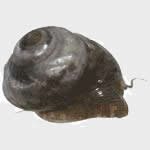Margarita Snail - Margarites pupillus
Taxonomy
Kingdom: Animalia
Phylum: Mollusca
Class: Gastropoda
Order: Archaeogastropoda
Family: Trochidae
Genus: Margarites
Species: pupillus
Margarites pupillusis not listed in CITES or on the IUCN Red List of Threatened Species.
This snail is known under many different common names in English, including Margarita snail, Little Margarita, Pearl snail, and Pearly Topped Snail. Margarita is the Latin word for pearl.
Geographical range, habitat and habits
The Margarita snail lives in the Indo-Pacific, deep down where the temperature is comparatively low.
The Margarita snail is found on rocks and sand in the wild. It is a nocturnal species that prefers to stay hidden during the day.
Size and appearance
The Margarita snail can attain a size of 1-2 inches.
The body of the snail is protected by a turban-shaped smooth shell which. The species occur in grey and brown colours.
Margarita snail care
First and foremost, it is not a good idea to add this species to a typical reef system with a water temperature of 80° F / 27 °C or so, because the Margarita snail lives deep down in the ocean where the temperature is much lower. Unfortunately, you can still see this species being marketed as “the perfect clean-up snail for reef tanks”. It is true that they are great at cleaning up – they are veracious algae eaters – but being kept in tropical heat shortens their lives significantly.
The aquarium should ideally contain both sand and rocks, and the Margarita snail needs to be given good hiding spots, e.g. caves and crevices, to seek shelter in during the day. Live rock / live sand is recommended.
As mentioned above, it is important not to house Margarita snails in warm aquariums. The recommended temperature range is 50-60° F / 10-15° C, but some aquarists have successfully kept this species in temperatures up to 68° F / 20° C. The pH-value should be in the 8.0-8.4 range and the specific gravity at 1.023-1.025.
The Margarita snail is fairly easy to keep in a temperate aquarium, but you must refrain from using copper based medications. It is also important to keep an eye on the levels of soluble waste since this snail is sensitive to nitrates.
The Margarita snail is non-venomous and non-aggressive and can be combined with other peaceful cold water marine creatures, including invertebrates. It is generally not recommended to keep more than one Margarita snails per 2 gallons / 7.5 litres of water. This species is reef-safe, but should not be kept in warm reef aquariums due to reasons stated above.
Feeding Margarita snail
The Margarita snail is an herbivorous snail that feeds on phytoplankton, including cyanobacteria / blue-green algae, brown and green diatoms, and hair algae / filamentous algae. Be prepared to supplement naturally occurring algae with other foods, e.g. dried seaweed, to ensure optimal nutrition. You can use an algae clip to secure the food or simply wrap a sheet of algae around a rock and place it next to the glass.
The shell of the Margarita snail is made up by calcium which the snail absorbs from its environment. The calcium level in the aquarium should therefore be kept at 350-450 ppm to ensure proper shell growth and strength.
Breeding Margarita snail
The Margarita snail reproduced sexually. The male and the female snail release eggs and sperm into the water where fertilization takes place.
The Margarita snail does not generally breed in aquaria.

